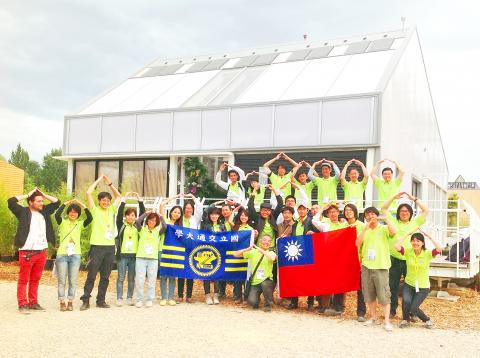A team from National Chiao Tung University (NCTU) won second place for innovation and third place in a general popularity vote at the European Solar Decathlon in Paris with its “Orchid House” design.
Despite being the first time that NCTU’s Team Unicode had ever competed in a competition, the team took home four awards at one of the world’s most prestigious universities, including first place in urban design, second place for innovation, third place for energy efficiency and third place in the most popular category, setting a new record for the university and Taiwan.
NCTU president Wu Yan-hwa says that Team Unicode’s record-breaking excellence has allowed the international community to see the strengths of Taiwan and the university. They have worked hard at chasing and making their dreams come true and the university is exceptionally proud of them, Wu says.

Photo courtesy of National Chiao Tung University
照片由國立交通大學提供
David Tseng, head of NCTU’s College of Humanities and Social Sciences and a professor in the Graduate Institute of Architecture, says that his first architectural piece was not completed until 12 years after he had graduated from graduate school at Harvard University in the US, and is therefore happy to see the students be able to finish a house as graduate students.
NCTU says that the European Solar Decathlon for sustainable architecture is basically the Olympics and World Expo rolled into one, making the competition one of the most important architectural design competitions in the world. It allows countries to compare their soft power competetively for top academic and industry research and development. The Decathlon requires academia and industry to work together, with teachers and students from the world’s top universities and the cream of the crop from the research and development industry visualizing, designing and executing designs for sustainable environments, green energy and smart living, ultimately creating a real house that is both forward-thinking and immediately accessible, the school says.
(Liberty Times, Translated by Kyle Jeffcoat)
國立交通大學建築所蘭花屋團隊在歐洲太陽能十項全能綠建築競賽中,再拿下創新獎項第二名,及公眾票選獎第三名。

Photo courtesy of National Chiao Tung University
照片由國立交通大學提供
交大Unicode團隊首次出征,即在國際一流頂尖大學環伺下,拿下都市設計大獎第一名,創新大獎第二名,能源效能第三名,以及最佳人氣獎第三名共四個獎項,創下交大及台灣紀錄。
交大校長吳妍華表示,蘭花屋Unicode團隊表現破表,讓國際看到台灣及交大的實力,他們努力追求且實現夢想,讓交大感到無比驕傲。
交大人文社會學院院長、建築研究所教授曾成德表示,他自己的第一棟建築作品,是在美國哈佛大學研究所畢業後十二年才完成,很高興看到學生們在研究所時期,就完成了一個房子。
交大表示,永續建築十項全能競賽堪稱是奧運賽與世博會合體的指標性未來建築設計大賽,比的是各國頂尖產學研發能量的軟實力競賽。而且比賽內容需產學攜手合作,由世界頂尖一流大學的師生與研發產業,針對永續環境、綠色能源與智慧生活構想、設計並執行一棟具有前瞻性但又即刻可行的「實品屋」。
(自由時報記者洪美秀)

In an effort to fight phone scams, British mobile phone company O2 has introduced Daisy, an AI designed to engage phone con artists in time-wasting conversations. Daisy is portrayed as a kindly British granny, exploiting scammers’ tendency to target the elderly. Her voice, based on a real grandmother’s for authenticity, adds to her credibility in the role. “O2” has distributed several dedicated phone numbers online to direct scammers to Daisy instead of actual customers. When Daisy receives a call, she translates the scammers’ spoken words into text and then responds to them accordingly through a text-to-speech system. Remarkably, Daisy

Bilingual Story is a fictionalized account. 雙語故事部分內容純屬虛構。 Emma had reviewed 41 resumes that morning. While the ATS screened out 288 unqualified, she screened for AI slop. She could spot it a mile away. She muttered AI buzzwords like curses under her breath. “Team player.” “Results-driven.” “Stakeholder alignment.” “Leveraging core competencies.” Each resume reeked of AI modeling: a cemetery of cliches, tombstones of personality. AI wasn’t just changing hiring. It was draining the humanity from it. Then she found it: a plain PDF cover letter. No template. No design flourishes. The first line read: “I once tried to automate my

Every May 1, Hawaii comes alive with Lei Day, a festival celebrating the rich culture and spirit of the islands. Initiated in 1927 by the poet Don Blanding, Lei Day began as a tribute to the Hawaiian custom of making and wearing leis. The idea was quickly adopted and officially recognized as a holiday in 1929, and leis have since become a symbol of local pride and cultural preservation. In Hawaiian culture, leis are more than decorative garlands made from flowers, shells or feathers. For Hawaiians, giving a lei is as natural as saying “aloha.” It shows love and

1. 他走出門,左右看一下,就過了馬路。 ˇ He walked outside, looked left and right, and crossed the road. χ He walked outside and looked left and right, crossed the road. 註︰並列連接詞 and 在這句中連接三個述語。一般的結構是 x, y, and z。x and y and z 是加強語氣的結構,x and y, z 則不可以。 2. 他們知道自己的弱點以及如何趕上其他競爭者。 ˇ They saw where their weak points lay and how they could catch up with the other competitors. χ They saw where their weak points lay and how to catch up with the other competitors. 註:and 一般連接同等成分,結構相等的單詞、片語或子句。誤句中 and 的前面是子句,後面是不定詞片語,不能用 and 連接,必須把不定詞片語改為子句,and 前後的結構才相等。 3. 她坐上計程車,直接到機場。 ˇ She took a cab, which took her straight to the airport. ˇ She took a cab and it took her straight